 Inspect your deck!
Inspect your deck!
Posted on Tuesday, January 23, 2018
By:
Sequoia Supply
Categories:
Deck Construction
It is estimated that there are over 30 million decks in the U.S. that are past their useful life and need to be replaced or repaired.
There may not be anything else on our property that we take
for granted like our deck. Think about it. It withstands year-around abuse from
sun, rain, snow, freezing temperatures and wind. Yet we exuberantly invite
friends and family over and head out on our trusty deck each spring. We expect
it to continue to support children, adults, pets, and drunks – as designed – without
giving it a second thought.
Key structural components on our homes like roof trusses and
wall studs are covered with protective items like shingles, siding, flashings
etc. In fact, by code, no structural component can be exposed to the weather.
But when it comes to your back-yard deck, the wood is exposed every single day and
left to deteriorate until it eventually fails. It is estimated that there are over 30 million decks in the U.S. that
are over 15 years old and the average healthy life-span of a deck is 10 – 15 years.
According to the Consumer Product Safety Commission (CPSC),
an average of 33,000 people per year are injured because of the structural
failure or collapse of a deck, porch, railing, or staircase. Six thousand of
them suffer traumatic injuries.
Outdoor living can vastly enhance the pleasure and quality
of our lives. A deck that is well-built can make an important contribution to that
aspect of our lifestyle. Don’t put the safety of your family and friends at risk.
Know what to look for, and do it! Carefully inspect your deck yearly. Repair
what can be repaired, reinforce what needs to be reinforced, replace what needs
to be replaced. And when the point comes that the entire deck needs to be
replaced, do it! Owners of faulty decks or
balconies can be sued or even prosecuted criminally.
The Ledger Board!
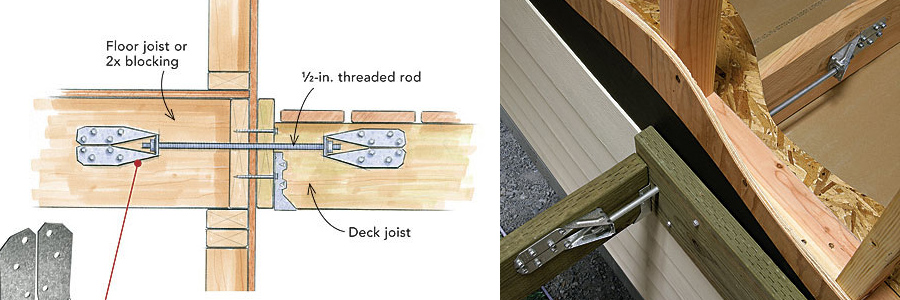
The vast majority of deck and balcony collapses are a result
of the ledger board pulling away from the house. The ledger board runs parallel
to the house, is attached to the house, and holds half the weight of the deck. In
past years, prior to stringent codes and people actually adhering to building code
requirements, ledger boards were often only held to the house with nails. This
is radically insufficient to put it lightly. Building code strictly prohibits
the “use of toenails or nails subject to withdrawal” when making this
connection. Thousands of pounds hang on the ledger and, over time as the wood
dries and deteriorates, the nails pull away. This epic failure has been
repeated hundreds of times and injured and killed hundreds of people.
Older decks should be inspected and retrofitted with modern,
code-approved ledger fasteners like the Simpson
StrongTie DTT2 Deck Tension Tie. This advanced fastener not only supports straight
vertical gravity load, but also provides critical lateral load resistance to
the deck by tying the joist of the deck directly to the joist of the house or
adjacent structure. These should be a standard method of fastening ledgers on
all new decks, but should also be used to retrofit and enforce existing decks.
Visit the StrongTie Deck
Center for complete details on this and dozens of other fasteners that make
and keep your deck safe.
Rotted Wood
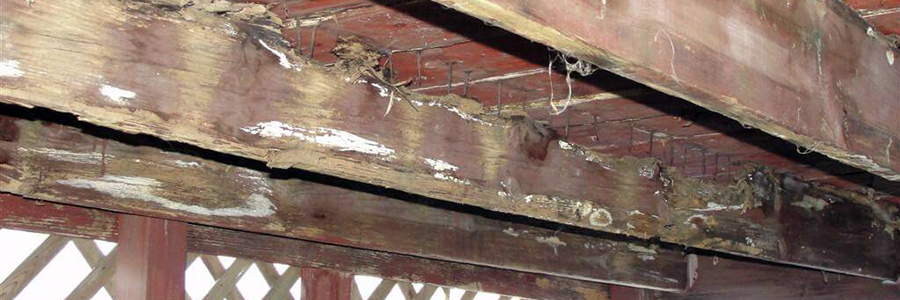
Seeing a small spot of rotted wood and doing nothing about
is like permitting an infection to spread in your body. It’s not going to fix
itself and will continue to worsen. Pay special attention to any areas that
tend to remain damp, are regularly exposed to water, or are in contact with
fasteners. Use a tool like an ice pick or a screwdriver to penetrate the wood
surface. If you can easily penetrate ¼” – ½”, break off a sliver of wood
without splinters, or the wood is soft and spongy, decay may be present. This
is also a good time to look for small holes in the wood, which may indicate
insects. Rotted wood pieces should be removed and replaced. When visible rot is widespread and extensive as in the photo above, it's time to demolish and replace your entire deck.
Loose, Weak or Inadequate Railing
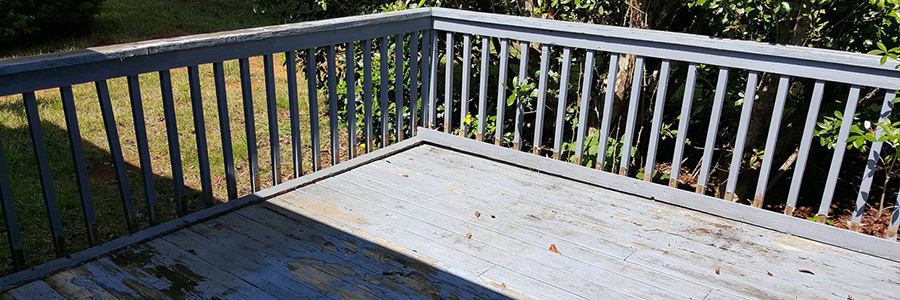
Deck railing is an essential safety feature. The higher the
deck off of the ground, the more important the railing becomes. The railing is
also the natural gathering spot where people hang out, lean, set their
beverages, and rush to see the results of the cornhole game or the arriving
bride and groom. Railings are designed to give people a place to lean against
just a little bit – providing approximately 200 pounds of lateral support – and
provide a border for the deck.
Shake each section of rail. Movement should be minimal. If
it feels excessive, get beneath the deck and check the bolts that support the
deck posts where they attach to the deck structure. Look for loose bolts, loose
nuts, or rust. Tighten or replace rail bolts as required. Simpson StrongTie DTT2 Deck Tension Tie can and should also be used to reinforce loose deck rail posts or install new deck rail posts.
Back on top of the
deck, inspect each connection where a rail section attaches to a rail post and
replace any loose or corroded fasteners. What? No posts? Deck rails which contain only balusters and no 4x4 or larger deck posts spaced no further than 8' apart are inadequate, dangerous and do not meet code. Fix it!
Rusty & Corroded Hangers & Fasteners
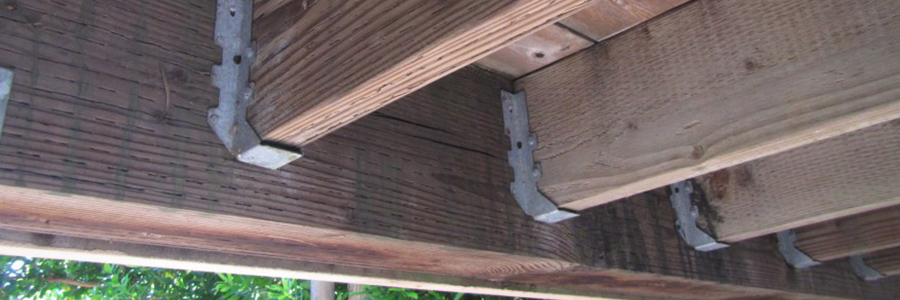
From beneath your deck, inspect the ends of all floor joist
where they meet a beam or the ledger board. Make sure that joist hangers are
applied where modern code requires and make sure that all joist hangers,
beam-to-post connections, and other metal fasteners are tight and free from
rust. All pre-punched holes in hangers should be filled with an adequate
galvanized nail (NOT a roofing nail!). The hangers are designed to carry the
required load, only when the proper gauge and length of nail fills every hole
in the hanger. Tighten any loose fasteners, and pound in any nails that have
popped up. If a fastener appears rusted or corroded, consider replacing it. A
corroded fastener can cause deterioration in surrounding wood.
Stairs
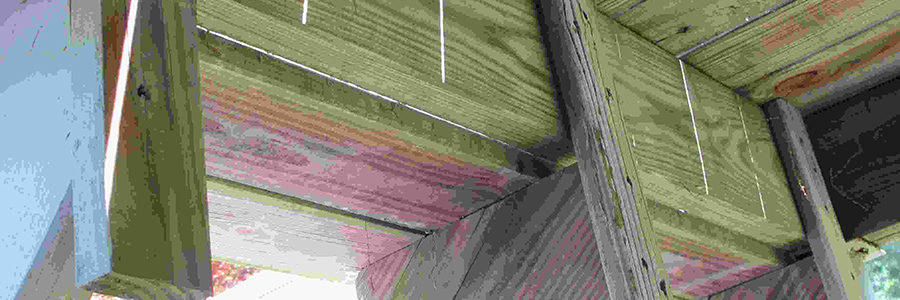
Check for any excessive splitting in the stair stringers to
which the treads and risers are attached. The deck and stairs should appear
even without sagging and should not sway or move when tested. Oh yeah, risers.
Make sure you actually have risers! Any opening greater than 4” is not
permitted. If your stairs only have treads and no risers, fix that! Check the
connection of the stringers to the deck to ensure that there is no separation.
If they are only secured with nails and not hangers or stair straps, install
the hangers and stair straps to reinforce the connection.
If there is no gate installed at the top of your stairs, install
one! Not only does it keep kids and party animals from falling down, it keeps other
uninvited animals from coming on your deck late at night.
Tagged:Decks, Deck Safety